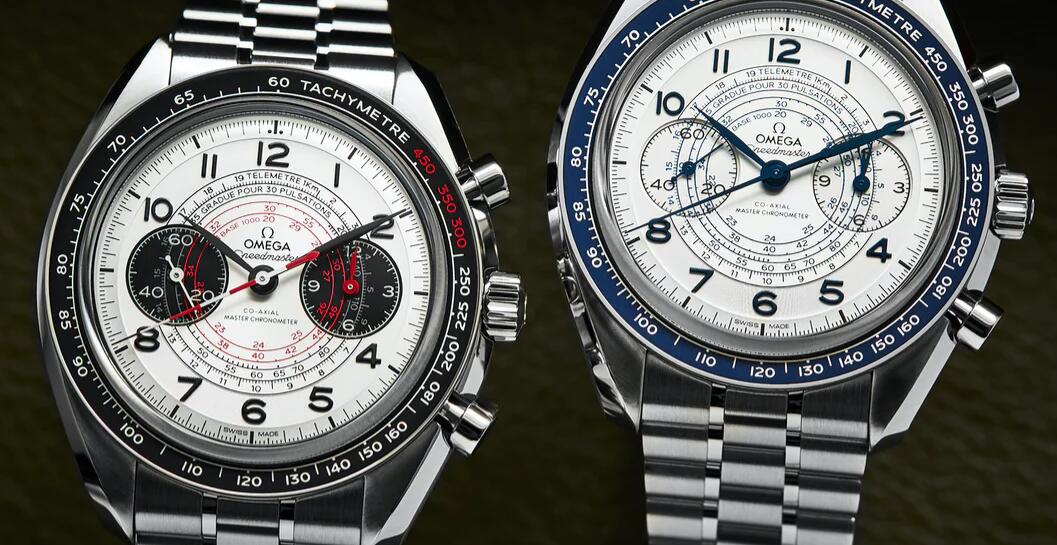
Omega Speedmaster Chronoscope Co-Axial Master Chronometer Chronograph
September 26, 2021Today Omega Speedmaster Chronoscope Co-Axial Master Chronometer Chronograph has announced the launch of the new Speedmaster Chronoscope Co-Axial Master Chronometer Chronographs. These are 43mm x 12.8mm watches, METAS/Master Chronometer certified, with a new co-axial hand-wound movement. The caliber 9908 is a hand-wound version of the automatic caliber 9900, and runs in 44 jewels at 28,800 vph. The movement is decorated with what Omega calls “arabesque” Geneva stripes, which, in a first for the company, are continued on the outer feet of the balance bridge as well.
The most notable feature of all models, is the presence of three different chronograph scales.
On the outer bezel, you’ll find the customary Speedmaster tachymeter scale, with measurements for units from 450 per hour to 60 per hour (generally the tachymeter scale is described as displaying speed over distance, and it certainly can be used for that but you can use it to calculate any units-per-hour measurement). For units less than 60 per hour, there is an additional inner tachymeter scale, which counts down from 55 units per hour to 20 units per hour, using a snail-type scale like those found on some vintage chronographs.
The outermost of the inner scales is a telemetric scale. This Omega Speedmaster Chronoscope Co-Axial Master Chronometer Chronograph is used to time how far away an event is, which is both audible and visible. The classic examples are the time difference between seeing lightning and hearing thunder, and between seeing the flash of an artillery shell and hearing the explosion – and if you find yourself using this scale with any frequency, you’re probably leading a more exciting and dangerous life than most of us.
Finally, there is a pulsometric scale. This is used to show the number of pulses (and therefore heartbeats) per minute – one hopes they are the same, anyway, or you may have problems more urgent than that distant thunderstorm. The scale is graduated for 30 pulsations – you start the chrono, and begin counting the pulse beats, up to thirty. When you hit thirty, you stop the chronograph, and read off the pulse/heart rate. If you count thirty pulses and the chrono stops at 60 on the scale, your patient’s heart is beating at 60 beats per minute.
At launch, there will be six models in stainless steel – two with silver dials and blued hands; two with blue dials and rhodium-plated hands; and two with silver dials and black subdials, with blackened hands. There will also be an additional model in Omega’s proprietary Bronze Gold. The alloy is 37.5% gold, with some silver and palladium added and the alloy is intended to give the warmth of bronze but also protect against corrosion better than conventional bronze alloys.
They’re gorgeous watches in the metal – at launch the Omega Speedmaster Chronoscope Co-Axial Master Chronometer Chronograph will have the white and blue model, and the panda model with red accents. That means that so far they’re the only ones we’ve had a chance to see in person but they’re so sharp they should come with a warning to not cut yourself looking at them (a joke I stole from Kung Fu Panda, appropriately enough).
In steel, for $8,650 bucks you’re getting a pretty loaded watch. The Master Chronometer rating means you can expect 0/+5 seconds per day maximum deviation in rate plus sufficient resistance to magnetic fields that you won’t have to worry about a magnet throwing off the rate unless you happen to – I don’t know, fall into a neutron star or something.
On the name: “Chronoscope” like “chronograph” has Greek roots and means, roughly, “seeing time” – hence, an instrument for displaying time and time measurements. While “chronograph” is enshrined in modern usage by tradition, it’s actually something of a legacy term as it means “writing time” and was coined to describe the action of inking chronographs (most of which were actually timers, not chronographs as we use the term today).
The only potential gotcha is that it’s a fairly big watch, at 43mm, but the Chronoscope is actually thinner than the hand-wound Master Chronometer Moonwatch (which is 42mm x 13.58) so the proportions feel right on. Plus, I’m straining my no-longer-quite-so-young eyes to see the dial clearly at 43mm. There’s nothing if not a fair bit of information on the dial and I don’t think I’d want it much smaller – go down in size on the scales and they start to become more purely decorative than potentially useful.
If you’re looking for a watch that is extremely up-to-date technically, but has all three of the classic chrono scales – pulsometer, telemeter, and tachymeter – the Chronoscope doesn’t have a whole lot of competition. If you like the information density of vintage triple scale chronos, but you want something capable of coping with modern life (and with a clearer dial than you find on many triple scale vintage chronos, which typically have undergone at least some deterioration) the Chronoscope is very much worth a look.
